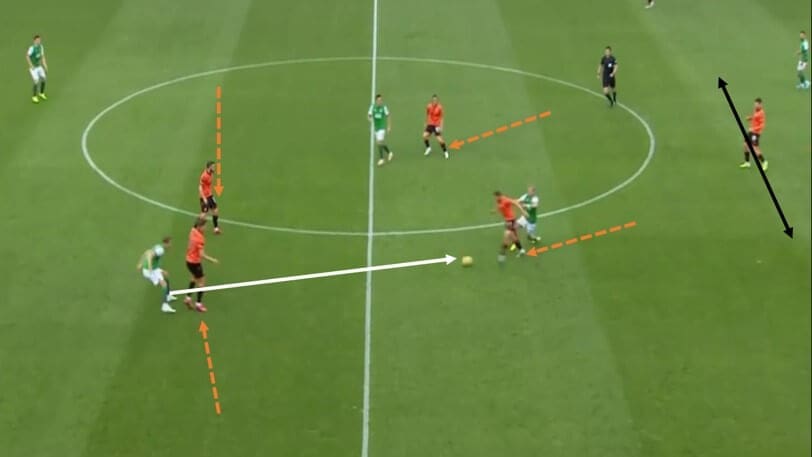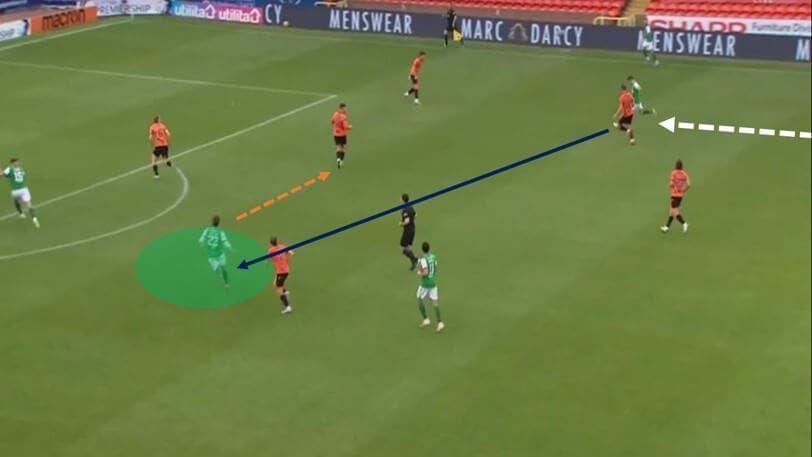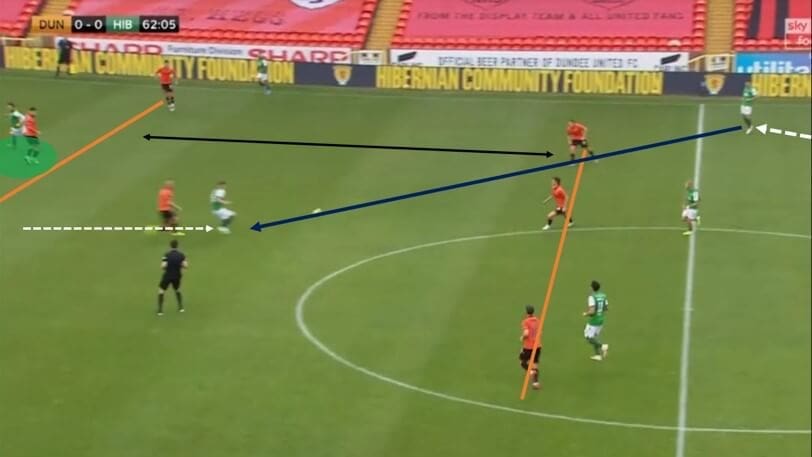With a number of players disobeying strict procedures, the Scottish Premiership was at risk of being stopped. Fortunately, just the teams in question, Aberdeen and Celtic, have had their games suspended for a week meaning that the Dundee United Hibernian game went ahead as planned. Both teams came into this game at Tannadice with great momentum with both coming away with away wins.
Micky Mellon got his first victory as Dundee United boss in a tricky away game to Motherwell. Dundee United’s opposition, Hibernian are enjoying life being top of the pile ahead of the likes of Celtic and Rangers as Jack Ross’ side kept their 100% record on the weekend.
Hibernian ensured their faultless streak continued in Dundee as they overcame Mellon’s men in a very cagey game. Both sides had very few clear cut chances on the night but it was Christian Doidge’s clinical nature that was the difference between the sides on the 65th minute as he crashed the ball to the roof of the net from a tight angle continuing on his impressive goalscoring record from last season.
This tactical analysis will focus on the tactics of both teams and explain how Dundee United started brightly and did well to overwhelm Hibernian with there energy and intent to regain the ball back. This analysis will also look at how Ross changed his team shape which ensured they started to control the game and thus create more chances which resulted in them getting their second away win on the bounce to stay in a Champions League position at the top of the table.
Lineups

Mellon set up his side in a 3-5-2 formation moving away from the 4-4-2 shape he employed against Stephen Robinson’s Motherwell side. With Mellon’s preference being a back three in this game he made the necessary changes to accommodate this switch as two players came into the side. Ryan Edwards made his debut for the side and started on the right of the back three as he replaced Liam Smith. Mellon’s other change was in the forward line as Nicky Clark came in for Logan Chalmers who dropped to the bench.
Ross elected not to change his team’s shape as he set up his side in a 4-4-2 formation. The former Sunderland did not make any personnel changes as he was quite happy with his side that comprehensively beat Livingston 1-4 in West Lothian on the weekend. Hibernian put on a great attacking display in the Tony Macaroni Arena with left-back Josh Doig, both wingers Martin Boyle and Daryl Horgan being a big influence in this great performance and were rewarded with a starting place once more. Upfront Kevin Nisbet stole the headlines on the weekend scoring a hat-trick, he paired up with Christian Doidge to make up the dangerous front two.
Dundee United progress the ball using their wing-backs
Mellon’s men started the better side and play played most of the football in the early proceedings controlling the game. Much of this control came in the way Dundee United setup against Hibernian as we see from the previous point. Mellon’s side, therefore, had the numerical advantage by playing three at the back against Hibs’ front two and in the midfield line as they had a 5 vs 4 advantage. Dundee United looked to build out from the back and could easily do so with these superior numbers in the build-up phase.
The Tangerines back three spread wide across the pitch to make it difficult for Hibs front two to put the necessary pressure on the ball and affect the play. The wingbacks would stay wide a push up slightly but still involved in the build-up and providing a passing option, as soon as the ball was played out to one of the wide centre-backs the Hibs ball side winger was occupied by the wing-back and back in his midfield line.
However, the wide centre-back was normally in space (as there was space either side of Hibs front two from the Dundee United back three splitting wide) and so is able to dribble forward which engages the ball side winger making him shoot out of his line. As the winger approaches to put pressure on the ball the wide centre-back could then see the winger coming and play around the winger to his wing-back who is now free. Both Dundee United wingbacks were essential to The Tangerines clean build-up and progression of the ball forward as we can see in the example below.
Dundee United’s right centre-back Edwards is in possession and engages Hibernian’s second line as left-winger Daryl Horgan shoots out of his line to press the centre-back. Hibernian’s central midfielder Joe Newell notices this and shuffles across ready to cover Dundee United’s ball near wing-back. Edwards realises this and plays the ball back to Mark Connolly who is positioned just at the edge of his own box.

With Hibernian’s central midfielder shuffling across it causes Boyle their right-winger to tuck in off his wing to protect and close the space in the middle of the pitch. This action, however, frees up the ball far wing-back Jamie Robson who positioned not too far up the pitch but wide so he can receive a pass, as we see above. Once Connolly receives the ball he looks up almost knowing his left wing-back would be free and plays a ball directly to him switching the play as we can see below.

Even though Boyle is extremely quick he can’t make up the ground in time and Robson cushions his header inside to Nicky Clark who has dropped deep in the space behind the Hibernian midfield line, with three passes Dundee United have progressed the ball forward past Hibs’ first two lines and thus can attack Hibernian’s backline.
Although Mellon’s side were easily able to progress the ball up to the final third through the utilisation of their wing-backs, the Tangerines did not show the composure bearing down on Hibs’ backline and so couldn’t create many clear cut chances. Dundee United’s deficiencies in this area came through a mixture of substandard execution or more commonly through poor decision making as we can see below. As Dundee United progress the ball through their left wing-back Adrian Spörle who replaced Robson as he picked up a nasty head knock.

The Argentinian defender does well to dribble inside opening up his passing options, he does the hard part but if he looks up he would see that right wing-back Luke Bolton is free in plenty of space on the opposite wing. Spörle instead whether it be that he is using weaker foot or he doesn’t see the new signing he plays the ball into the congested central area and the attacking move breaks down. The use of both wing-backs got Mellon’s men up the pitch into the attacking third but they didn’t have the cutting edge in the final third to create the type of chances needed to break the deadlock.
Tangerines aggression out of possession
Dundee United’s shape certainly aided them in possession as they created overloads to progress through Hibs’ pressure, as aforementioned but these favourable matchups also helped Mellon’s men when Hibernian had the ball. This numerical advantages in midfield and in their backline meant that the Tangerines could be more aggressive out of possession as Hibs tried to build out from the back.
Hibernian usually accessed their full-backs when trying to progress the ball forward and whichever side of the pitch Hibs looked to build from it determined Dundee United’s shape, we can see the setup from Mellon’s team below. As the ball near wing-back is tasked with pushing up and pressing the Hibernian’s left full-back. Dundee United then tended to commit two players to aggressively press Hibernian’s two central midfielders from behind. Both Dundee United midfielders stayed in close proximity before trying to nick in and regain the ball as it looked like the Hibernian midfielder would receive the pass off their teammate.

Hibernian’s left-back Doig decides to play a pass into Alex Gogić but before he takes the ball into him he is pressed from behind by Ian Harkes and this forces Gogić to kick the ball out of play for a Dundee United throw-in. Also, note that Mellon’s side has done well to shut off any potential passing options for the former Hamilton midfielder when he receives the pass and this pressure costs his team and hands back possession to the Tangerines.
What is also interesting about Mellon’s sides out of possession shape was how effective the players were at carrying out their roles both ahead and behind the three committing to the aggressive press in midfield (the ball side wing-back and two central midfielders) as Hibernian tried to play out from the back. Ahead of these players, the front two worked extremely hard at shutting off both Hibernian centre-backs as an option and if they did get the ball they pressed the ball player at times trying to double up on him, as we can see below.

Hibs centre-back Ryan Porteous is trying to play the ball out and is pressed by both United strikers which force him to try and find Gogić in between them, but the Dundee United central midfielder anticipates this pass and nicks in ahead of the Hibs player regaining the ball back to launch an attack. Also, note that behind the Dundee midfield that the ball far wingback who is out of the picture has dropped back to form a back four with the back three.
We can also see in the above image, directly behind the ball winner that Dundee United’s extra man in the middle Calum Butcher is slightly deeper screening in front of the backline which allows the other two in midfield in front of him to be that bit more aggressive knowing the central area is protected behind them. He is also positioned well if Hibernian decided to go long to their front two as he is able to pick off any potential knockdowns or second balls.
Hibernian’s change of shape ensure they start dictating the play
Hibernian could not get into the game in the first half and this was mainly down to their 4-4-2 formation in which they started the game with as Dundee United were able to create overloads which saw them control the game on both sides of the ball, as mentioned in the previous points above. Ross smartly decided to change from this 4-4-2 to a 3-4-1-2 formation at the interval for the second half. Boyle dropped back into a right wing-back position as Paul McGinn moved back from his full-back position to form the back three with Doig operating on the opposite side as the other wing-back, Daryl Horgan played behind the front two.
Hibernian just matched up with Dundee United shape and Ross’ men really started to play the ball around for more sustained periods as the Tangerines did not come out with the same intent as they did in the first half almost like the players were expecting Hibs to play in their 4-4-2 formation and this disrupted them as they tried to come to terms with the new shape in front of them.
Dundee United played quite deep as a result and Hibernian were able to progress the ball much easier taking advantage of the 3 vs 2 created in the first phase of play. Paul McGinn was the main ball progressor as he drove forward utilising the space in the right channel (from the Hibs back three in which he was a part of encouraged to spread wide) making it difficult for the Dundee United striker to recover and put pressure and stop McGinn’s efforts. The introduction of a more creative player focal point in the form of Scott Allan made a difference as he replaced Horgan and played in behind the front two adding the threat of Dundee United defensive unit being unlocked with his great passing and vision, we see both McGinn and Allan link up in a good Hibs move below.

McGinn receives the ball in the build-up phase in space and with Dundee United so deep he drives forward with the ball unopposed. We see how the Tangerines have not grasped the change of shape from Hibernian as Butcher continues to try to play the same role as he did in the first half and screen in front of the backline not realising he now has a responsibility to mark a man, Allan, who is now free (circled green) in a dangerous position. Nicky Clark tries to put some pressure on McGinn by getting back but the Hibs right centre-back is able to play a diagonal ground pass to Allan who tries to link with Nisbet but the striker takes a poor touch in the box, a let-off for Dundee United.
Mellon tried to inject the same energy and intent that his team had in the first half and was obviously not happy with how Hibernian were able to progress the ball so easily in the move above. Dundee United’s midfield line pushed up, as a result, to stop McGinn’s driving runs deep into the Tangerines half through the right channel. Once McGinn got the ball right wing-back Boyle positioned himself high and wide like a right-winger alongside the same line as the Hibs front two in an advanced position which pushed back Dundee United’s defensive line, creating acres of space between the lines, as we can see below.

With the defensive line not mirroring their midfield line by pushing up, it causes them to be disjointed. McGinn comes forward with the ball but another problem along with the huge amount of space in between the lines is that Mellon’s midfield line is not putting the necessary pressure on the Hibs ball carrier so he has time to pick his head and deliver the right pass forward unopposed.
Also note above that Butcher decides to start to man-mark Allan to stop his influence on the game but the Hibs midfielder (circled in green) cleverly pushes high alongside Boyle and his strikers vacating the space in the middle as Nisbet drops off the line to receive the ball in this space in between the lines which is played into him by McGinn and Hibs create a half-chance at the end of this move. Hibs change of shape helps them gain control of the game and there sustained pressure leads to them grabbing the opening/winning goal in the game.
Conclusion
Micky Mellon set up his team with great energy and application on top of a foundation of being so well organised shape with each one of his players know their roles and where they need to be positionally in the system which saw them dominate and control majority of the first half. Dundee United did not take advantage of this dominance and it was their play in the final third which lacked any cutting edge through a mixture of players making the wrong decisions or from poor execution to create the clear opportunities needed to capitalise on their first-half pressure. The former Tranmere Rovers boss will also have to improve his players reactions and adapt to changes like what happened in the second half in this game, as mentioned above in this analysis.
Jack Ross would not have enjoyed how his team played in the first half as they were unable to progress the ball and retain the possession as they were overwhelmed with Dundee United’s shape and aggression. The former Sunderland will be very encouraged by flexibility in his team as they are able to change formations and systems in the middle of a game and are comfortable playing with a back four or three which turned out to be pivotal in turning the game around in their favour but also going forward in other matches makes them extremely difficult for oppositions teams to prepare for, Motherwell have this hard task next to stop this high flying Hibs side.





Comments